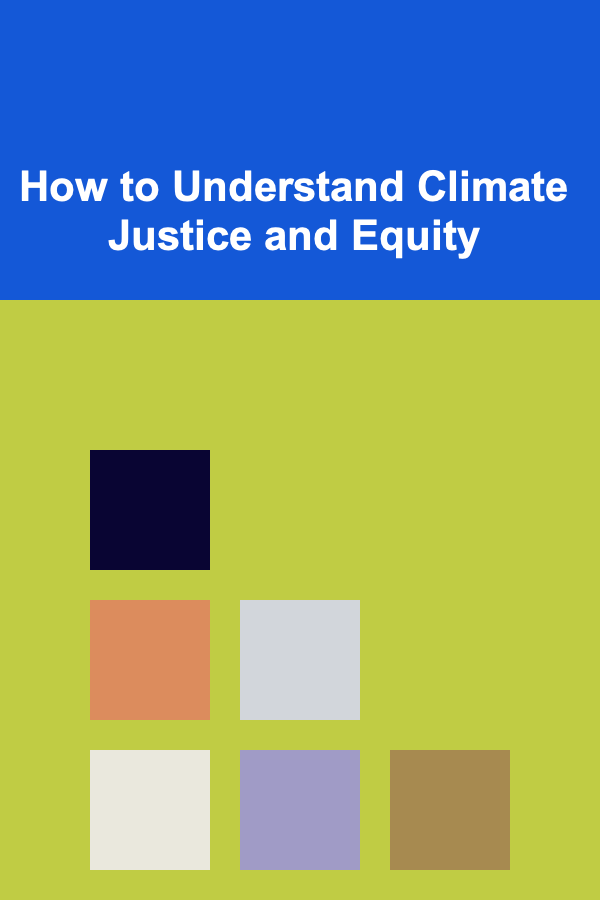
How to Understand Climate Justice and Equity
ebook include PDF & Audio bundle (Micro Guide)
$12.99$6.99
Limited Time Offer! Order within the next:

Climate change is one of the most pressing global challenges of the 21st century. Its impacts are widespread, touching every aspect of human life, from health and economic stability to social structures and environmental integrity. As the planet continues to warm, the importance of addressing climate change through policies, actions, and frameworks that are just and equitable becomes ever more urgent. This is where the concepts of climate justice and equity come into play. These concepts not only focus on the environmental aspects of climate change but also on the social, economic, and political dimensions, aiming for solutions that ensure fairness for all individuals, especially those most vulnerable to its impacts.
Defining Climate Justice and Equity
At its core, climate justice refers to the recognition that climate change is not just an environmental issue but a social and ethical issue that has far-reaching implications for human rights. It acknowledges the disproportionate effects of climate change on marginalized and vulnerable communities, particularly those who have contributed the least to the problem. Climate justice calls for policies and actions that not only mitigate the impacts of climate change but also address the inequalities it exacerbates.
Climate equity, on the other hand, focuses on ensuring that the burdens and benefits of climate action are shared fairly. It emphasizes the need for fair treatment of all people, particularly those who are most at risk of climate-related harms. Equity, in this context, involves both the fair distribution of the costs of addressing climate change and the fair allocation of its benefits.
Both concepts are closely intertwined. Climate justice is about addressing the root causes of inequality in the context of climate change, while climate equity seeks to ensure that everyone has a fair opportunity to contribute to and benefit from solutions to climate change.
The Unjust Realities of Climate Change
The Disproportionate Impact on Vulnerable Communities
One of the key principles of climate justice is that the impacts of climate change are not felt equally. While everyone on Earth is affected by rising temperatures, extreme weather events, and shifting ecosystems, vulnerable communities bear the brunt of these changes. These groups often include low-income populations, people of color, indigenous communities, and developing nations that have historically contributed the least to greenhouse gas emissions but are the most affected by the consequences of climate change.
For instance, in many parts of the Global South, rising sea levels threaten to submerge entire coastal regions, displacing millions of people. At the same time, these nations have the least resources to adapt to or mitigate the impacts of such drastic changes. Similarly, marginalized communities within wealthier nations, including people of color and low-income groups, are more likely to live in areas that are prone to extreme weather events such as floods, hurricanes, and wildfires. These communities often lack the infrastructure, resources, and political power to protect themselves, making them more vulnerable to climate impacts.
Moreover, climate change exacerbates existing social inequalities. It disrupts livelihoods, deepens poverty, and intensifies conflicts over resources such as water and land. Indigenous communities, for example, often face the destruction of their ancestral lands and cultures due to the exploitation of natural resources driven by climate change. The loss of biodiversity, shifting weather patterns, and disruptions to agriculture threaten food security, further entrenching poverty and inequality.
Intergenerational Justice
Another important aspect of climate justice is intergenerational equity, which emphasizes the responsibility we have to future generations. The decisions made today regarding climate change will affect the lives of future generations, for better or worse. By not addressing the root causes of climate change and failing to transition to a sustainable, low-carbon economy, current generations are essentially imposing a heavy burden on future ones. This is especially unjust when considering that many of the most vulnerable populations to climate change, such as young children, will face the worst consequences.
Historical Injustices
Climate justice also requires acknowledging the historical injustices that have contributed to climate change. Developed nations, particularly those in the Global North, have been the primary contributors to the accumulation of greenhouse gases in the atmosphere. For centuries, these nations have industrialized and grown wealthier by exploiting natural resources, often at the expense of the environment and the people who lived in the regions from which these resources were extracted. The consequences of this historical exploitation continue to reverberate, with many developing countries now dealing with the aftermath of unsustainable practices they did not benefit from.
This historical perspective is crucial when discussing the responsibility of wealthy nations to take on a larger share of the burden in terms of climate mitigation and adaptation. This is the basis for the principle of "common but differentiated responsibilities" enshrined in the Paris Agreement, which recognizes that while all nations are responsible for addressing climate change, developed nations have a greater obligation due to their historical emissions and greater financial capacity.
The Role of Equity in Climate Solutions
Fair Distribution of Resources
One of the key components of climate equity is the fair distribution of resources, particularly financial and technological support, to those who need it the most. Wealthier nations and industries must provide financial assistance to developing countries to help them transition to renewable energy, adapt to climate change, and protect their communities. This financial support should be provided without the imposition of burdensome conditions that could further entrench inequality.
Moreover, technology transfer is another critical aspect of climate equity. Many developing countries do not have access to the cutting-edge technology needed to mitigate and adapt to climate change. Wealthier nations and companies should work to ensure that developing countries have the tools, knowledge, and infrastructure to build climate-resilient economies and societies. This includes renewable energy technologies, sustainable agriculture practices, and early warning systems for extreme weather events.
Inclusive Climate Policies
For climate action to be truly just, it must be inclusive. This means that the voices of vulnerable communities must be heard in the decision-making processes related to climate policy. Indigenous communities, low-income populations, and people of color should be actively involved in the design and implementation of climate solutions. This ensures that the policies created are reflective of the needs, knowledge, and perspectives of those who are most affected by climate change.
Inclusive policies also involve recognizing the disproportionate burden placed on certain groups. For example, policies designed to reduce emissions or promote renewable energy should consider the specific needs of low-income communities that may face higher upfront costs for transitioning to green technologies. This might include providing subsidies, incentives, or assistance programs to make sustainable energy solutions more affordable and accessible to everyone.
Climate Justice and Human Rights
Another dimension of climate justice is the integration of human rights principles into climate action. Climate change is not just an environmental issue; it is also a human rights issue. As climate impacts disrupt access to clean water, food, shelter, and healthcare, they threaten fundamental human rights. In this context, climate justice calls for the protection of human rights, particularly the rights of those who are most vulnerable to the impacts of climate change.
This includes the right to life, health, and development, as well as the right to self-determination for indigenous peoples. Climate justice demands that governments and businesses not only reduce greenhouse gas emissions but also ensure that climate policies do not undermine the rights and well-being of affected communities.
The Path Forward: How to Achieve Climate Justice and Equity
Global Cooperation
Achieving climate justice and equity will require unprecedented global cooperation. The challenge of climate change is too vast and complex for any one country to solve alone. Countries must come together to create international agreements that ensure fair and equitable climate action. The Paris Agreement, adopted in 2015, represents a crucial step in this direction, as it sets global targets for reducing emissions and provides a framework for financing climate adaptation and mitigation in developing countries.
However, while international agreements are important, they must be backed by strong domestic policies that prioritize equity and justice. Governments must ensure that their national climate actions take into account the needs of vulnerable populations and that the benefits of climate policies are widely distributed.
Climate Litigation
Another emerging tool in the fight for climate justice is climate litigation. As the impacts of climate change worsen, more individuals and communities are turning to the courts to hold governments and corporations accountable for their contributions to climate change. Through legal action, communities can demand that their rights to a healthy environment, protection from climate impacts, and access to climate justice are upheld.
Grassroots Movements and Advocacy
Grassroots movements also play a crucial role in advancing climate justice. From youth-led organizations advocating for climate action to indigenous groups fighting for the protection of their lands, these movements amplify the voices of those who are often excluded from traditional decision-making processes. By organizing and mobilizing communities, these groups help ensure that the fight for climate justice remains a priority and that the needs of the most vulnerable are addressed.
Conclusion
Understanding climate justice and equity requires recognizing the deeply entrenched social, economic, and political inequalities that shape the impacts of climate change. It is not enough to focus solely on reducing emissions or developing new technologies; we must also ensure that the solutions we implement are fair, inclusive, and designed to protect those who are most vulnerable to climate-related harms. By addressing the root causes of inequality and ensuring that the benefits and burdens of climate action are shared equitably, we can work towards a more just and sustainable future for all.
In the end, climate justice and equity are not just about addressing the impacts of climate change but about creating a more just, fair, and sustainable world. It is about ensuring that everyone, regardless of their background or circumstances, has the opportunity to thrive in a world that is not only resilient to climate change but also responsive to the needs and rights of all its inhabitants.

How to Build a Job Interview Checklist for Dealing with Unexpected Questions
Read More
How To Create Explainer Videos with Animation
Read More
How to Highlight Your Home's Best Features with Staging
Read More
How to Use Jarvis Cleaning Products for a Spotless Home
Read More
DIY Feng Shui Projects You Can Do This Weekend
Read More
How to Transition from Sales to Account Executive: A Career Guide
Read MoreOther Products

How to Build a Job Interview Checklist for Dealing with Unexpected Questions
Read More
How To Create Explainer Videos with Animation
Read More
How to Highlight Your Home's Best Features with Staging
Read More
How to Use Jarvis Cleaning Products for a Spotless Home
Read More
DIY Feng Shui Projects You Can Do This Weekend
Read More